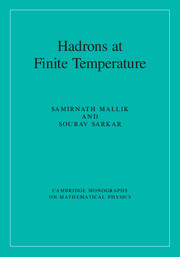Book contents
- Frontmatter
- Dedication
- Contents
- Preface
- Notation
- 1 Free Fields in Vacuum
- 2 Spontaneous Symmetry Breaking
- 3 Chiral Perturbation Theory
- 4 Thermal Propagators
- 5 Thermal Perturbation Theory
- 6 Thermal Parameters
- 7 Two-Loop Results
- 8 Heavy Ion Collisions
- 9 Non-Equilibrium Processes
- Appendix A General Fields
- Appendix B Global Symmetries
- Appendix C Exponential Operator
- Appendix D Propagator at Origin of Coordinates
- Appendix E Reaction Rates in Vacuum and Medium
- Appendix F Coupling Constants
- Appendix G Imaginary Time Method
- Appendix H Quark Condensate from Partition Function
- Appendix I Quark Condensate from Density Expansion
- Index
- References
4 - Thermal Propagators
Published online by Cambridge University Press: 27 October 2016
- Frontmatter
- Dedication
- Contents
- Preface
- Notation
- 1 Free Fields in Vacuum
- 2 Spontaneous Symmetry Breaking
- 3 Chiral Perturbation Theory
- 4 Thermal Propagators
- 5 Thermal Perturbation Theory
- 6 Thermal Parameters
- 7 Two-Loop Results
- 8 Heavy Ion Collisions
- 9 Non-Equilibrium Processes
- Appendix A General Fields
- Appendix B Global Symmetries
- Appendix C Exponential Operator
- Appendix D Propagator at Origin of Coordinates
- Appendix E Reaction Rates in Vacuum and Medium
- Appendix F Coupling Constants
- Appendix G Imaginary Time Method
- Appendix H Quark Condensate from Partition Function
- Appendix I Quark Condensate from Density Expansion
- Index
- References
Summary
Methods of thermal field theory can broadly be put into two categories, according to their use of imaginary time or real time in the ensemble averages. The method of imaginary time was first proposed by Matsubara [1]. The real time method was introduced later, originally by Schwinger [2] and Keldysh [3] and followed by others [4], who applied it to study non-equilibrium processes. It was also applied to equilibrium situations by Mills [5]. The real time method was reformulated in the so-called thermofield dynamics by Umezawa and collaborators [6], who suggested a doubling of field variables in the statistical context. Niemi and Semenoff [7] clarified this apparent doubling in terms of the time contour needed in the real time formulation. A survey of early literature is available in [8]. Physical applications including later works are presented also in books [9, 10].
For systems in thermal equilibrium, one can develop perturbative expansion in both methods in parallel to the conventional method in vacuum. The difference shows up in the form of the propagators. Because of the finite interval of imaginary time, the frequencies are discrete, giving the propagator as a sum over these frequencies. On the other hand, the real time method has two infinite intervals of time, giving rise to a 2 × 2 matrix for the propagator. The majority of calculations reported in the literature are done in the imaginary time method, avoiding matrix propagators in the real time method.
For systems out of thermal equilibrium, the real time method suggests itself as the appropriate framework to calculate physical quantities. However, for quantities such as the response functions (we address this problem in the last chapter) the end results relate to thermal equilibrium and so can be evaluated by either method. But, to follow the time dependence of quantities during non-equilibrium phases, such as in the early universe [11–13] – a topic too distant to discuss in this book – the real time method is the only option.
In this book we adopt the real time method to calculate thermal quantities in equilibrium. This chapter is devoted to deriving the matrix form of propagators arising in this method.
- Type
- Chapter
- Information
- Hadrons at Finite Temperature , pp. 94 - 117Publisher: Cambridge University PressPrint publication year: 2016



